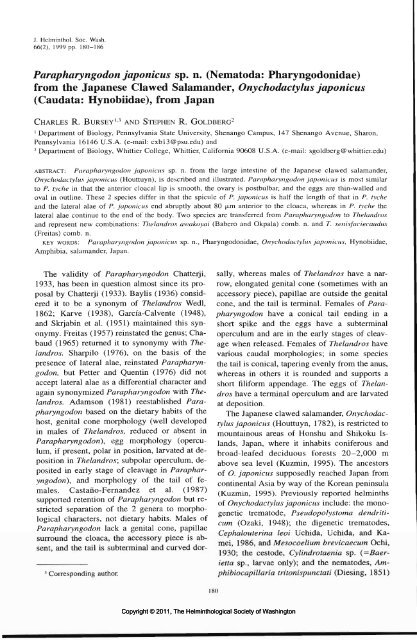The Helminthological Society of Washington - Peru State College
The Helminthological Society of Washington - Peru State College
The Helminthological Society of Washington - Peru State College
Create successful ePaper yourself
Turn your PDF publications into a flip-book with our unique Google optimized e-Paper software.
J. Helminthol. Soc. Wash.<br />
66(2), 1999 pp. 180-186<br />
Parapharyngodon japonicus sp. n. (Nematoda: Pharyngodonidae)<br />
from the Japanese Clawed Salamander, Onychodactylus japonicus<br />
(Caudata: Hynobiidae), from Japan<br />
CHARLES R. BURSEYU AND STEPHEN R. GOLDBERG2<br />
1 Department <strong>of</strong> Biology, Pennsylvania <strong>State</strong> University, Shenango Campus, 147 Shenango Avenue, Sharon,<br />
Pennsylvania 16146 U.S.A. (e-mail: cxbl3@psu.edu) and<br />
2 Department <strong>of</strong> Biology, Whittier <strong>College</strong>, Whittier, California 90608 U.S.A. (e-mail: sgoldberg@whittier.edu)<br />
ABSTRACT: Parapharyngodon japonicus sp. n. from the large intestine <strong>of</strong> the Japanese clawed salamander,<br />
Onychodactylus japonicus (Houttuyn), is described and illustrated. Parapharyngodon japonicus is most similar<br />
to P. tyche in that the anterior cloacal lip is smooth, the ovary is postbulbar, and the eggs are thin-walled and<br />
oval in outline. <strong>The</strong>se 2 species differ in that the spicule <strong>of</strong> P. japonicus is half the length <strong>of</strong> that in P. tyche<br />
and the lateral alae <strong>of</strong> P. japonicus end abruptly about 80 u,m anterior to the cloaca, whereas in P. tyche the<br />
lateral alae continue to the end <strong>of</strong> the body. Two species are transferred from Parapharyngodon to <strong>The</strong> land ros<br />
and represent new combinations: <strong>The</strong>landros awakoyai (Babero and Okpala) comb. n. and T. senisfaciecaiidus<br />
(Freitas) comb. n.<br />
KEY WORDS: Parapharyngodon japonicus sp. n., Pharyngodonidae, Onychodactylus japonicus, Hynobiidae,<br />
Amphibia, salamander, Japan.<br />
<strong>The</strong> validity <strong>of</strong> Parapharyngodon Chatterji,<br />
1933, has been in question almost since its proposal<br />
by Chatterji (1933). Baylis (1936) considered<br />
it to be a synonym <strong>of</strong> <strong>The</strong>landros Wedl,<br />
1862; Karve (1938), Garcia-Calvente (1948),<br />
and Skrjabin et al. (1951) maintained this synonymy.<br />
Freitas (1957) reinstated the genus; Chabaud<br />
(1965) returned it to synonymy with <strong>The</strong>landros.<br />
Sharpilo (1976), on the basis <strong>of</strong> the<br />
presence <strong>of</strong> lateral alae, reinstated Parapharyngodon,<br />
but Fetter and Quentin (1976) did not<br />
accept lateral alae as a differential character and<br />
again synonymized Parapharyngodon with <strong>The</strong>landros.<br />
Adamson (1981) reestablished Parapharyngodon<br />
based on the dietary habits <strong>of</strong> the<br />
host, genital cone morphology (well developed<br />
in males <strong>of</strong> <strong>The</strong>landros, reduced or absent in<br />
Parapharyngodon), egg morphology (operculum,<br />
if present, polar in position, larvated at deposition<br />
in <strong>The</strong>landros; subpolar operculum, deposited<br />
in early stage <strong>of</strong> cleavage in Parapharyngodon),<br />
and morphology <strong>of</strong> the tail <strong>of</strong> females.<br />
Castano-Fernandez et al. (1987)<br />
supported retention <strong>of</strong> Parapharyngodon but restricted<br />
separation <strong>of</strong> the 2 genera to morphological<br />
characters, not dietary habits. Males <strong>of</strong><br />
Parapharyngodon lack a genital cone, papillae<br />
surround the cloaca, the accessory piece is absent,<br />
and the tail is subterminal and curved dor-<br />
3 Corresponding author.<br />
sally, whereas males <strong>of</strong> <strong>The</strong>landros have a narrow,<br />
elongated genital cone (sometimes with an<br />
accessory piece), papillae are outside the genital<br />
cone, and the tail is terminal. Females <strong>of</strong> Parapharyngodon<br />
have a conical tail ending in a<br />
short spike and the eggs have a subterminal<br />
operculum and are in the early stages <strong>of</strong> cleavage<br />
when released. Females <strong>of</strong> <strong>The</strong>landros have<br />
various caudal morphologies; in some species<br />
the tail is conical, tapering evenly from the anus,<br />
whereas in others it is rounded and supports a<br />
short filiform appendage. <strong>The</strong> eggs <strong>of</strong> <strong>The</strong>landros<br />
have a terminal operculum and are larvated<br />
at deposition.<br />
<strong>The</strong> Japanese clawed salamander, Onychodactylus<br />
japonicus (Houttuyn, 1782), is restricted to<br />
mountainous areas <strong>of</strong> Honshu and Shikoku Islands,<br />
Japan, where it inhabits coniferous and<br />
broad-leafed deciduous forests 20-2,000 m<br />
above sea level (Kuzmin, 1995). <strong>The</strong> ancestors<br />
<strong>of</strong> O. japonicus supposedly reached Japan from<br />
continental Asia by way <strong>of</strong> the Korean peninsula<br />
(Kuzmin, 1995). Previously reported helminths<br />
<strong>of</strong> Onychodactylus japonicus include: the monogenetic<br />
trematode, Pseudopolystoma dendriticum<br />
(Ozaki, 1948); the digenetic trematodes,<br />
Cephalouterina leoi Uchida, Uchida, and Kamei,<br />
1986, and Mesocoelium brevicaecum Ochi,<br />
1930; the cestode, Cylindrotaenia sp. (=Baerietta<br />
sp., larvae only); and the nematodes, Amphibiocapillaria<br />
tritonispunctati (Diesing, 1851)<br />
180<br />
Copyright © 2011, <strong>The</strong> <strong>Helminthological</strong> <strong>Society</strong> <strong>of</strong> <strong>Washington</strong>
















